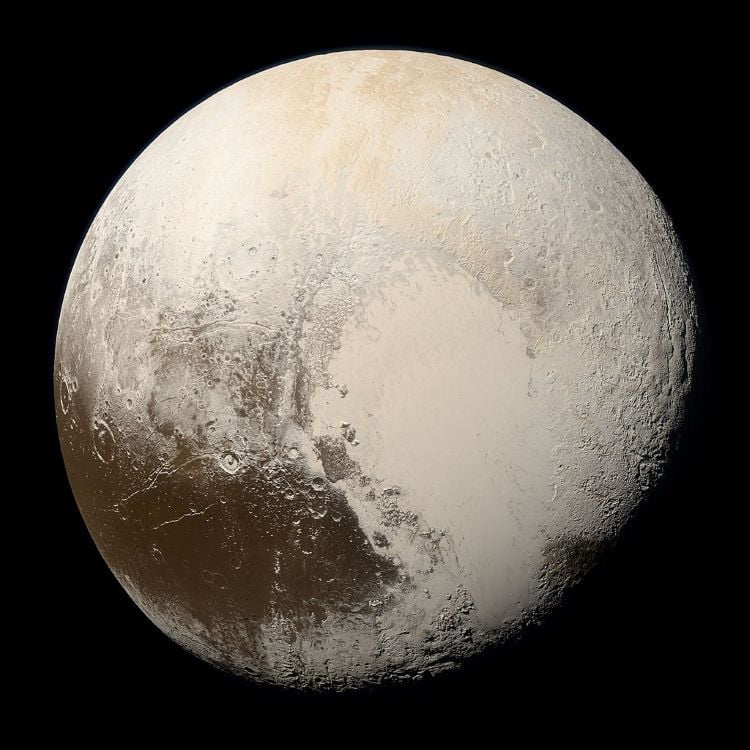Science
Researchers Uncover Evidence of Cryovolcanism on Pluto

A recent study published in *The Planetary Science Journal* has revealed potential signs of cryovolcanism in the Kildaze caldera, located in Pluto’s Hayabusa Terra region. This research aims to deepen our understanding of Pluto’s geological activity, particularly how it can persist in an environment so distant from the Sun.
The team of researchers utilized images from NASA’s New Horizons spacecraft, which conducted a flyby of Pluto in July 2015. By comparing the Kildaze caldera to other cryovolcanic sites on Pluto and analog locations on Earth and Mars, they aimed to identify evidence of past cryovolcanic activity. Among the sites analyzed were Pluto’s Virgil Fossae and Viking Terra, as well as Earth’s Yellowstone and Valles Caldera, along with Martian features like the pit craters in Noctis Labyrinthus.
To ascertain the origins of the water ice present in Kildaze, the researchers employed a combination of digital elevation models, elevation profiles, and three-dimensional visualizations. Their findings indicate that the water ice in Kildaze is estimated to be several million years old, significantly younger than Pluto itself. The study concludes that the Kildaze region likely represents a cryovolcano with a caldera structure that has experienced one or more eruptions, ejecting approximately 103 km3 of cryolava.
Cryovolcanism, characterized by the eruption of icy substances rather than molten lava, has been documented across various celestial bodies, including Ceres, Europa, and Enceladus. The study highlights that Pluto’s unique position—being the furthest from the Sun—challenges the notion that solar influence is essential for cryovolcanic activity.
Debate continues among scientists regarding the sources of Pluto’s internal heat. Some theories suggest that tidal heating from interactions with its largest moon, Charon, may play a crucial role. A 2022 study published in *Icarus* proposed that this tidal heating enables Pluto to retain heat long after Charon’s own internal heat has dissipated. Alternatively, it’s possible that some of Pluto’s heat originated from its formation billions of years ago.
Since the historic encounter of New Horizons in 2015, it remains the only spacecraft to have visited Pluto. Several upcoming missions have been proposed, including a fusion-powered orbiter-lander combination that could reach Pluto in just four years. For comparison, New Horizons took nine years on its journey.
As scientists continue to analyze the extensive data collected by New Horizons, they remain hopeful regarding new insights into Pluto’s geological activity and the implications of its cryovolcanic history. The quest to understand this distant dwarf planet continues, underscoring the importance of ongoing exploration and research in planetary science.
-

 Sports1 week ago
Sports1 week agoSteve Kerr Supports Jonathan Kuminga After Ejection in Preseason Game
-

 Politics1 week ago
Politics1 week agoDallin H. Oaks Assumes Leadership of Latter-day Saints Church
-

 Business1 week ago
Business1 week agoTyler Technologies Set to Reveal Q3 2025 Earnings on October 22
-

 Lifestyle1 week ago
Lifestyle1 week agoDua Lipa Celebrates Passing GCSE Spanish During World Tour
-

 Entertainment1 week ago
Entertainment1 week agoZoe Saldana Advocates for James Cameron’s Avatar Documentary
-

 World1 week ago
World1 week agoD’Angelo, Iconic R&B Singer, Dies at 51 After Cancer Battle
-

 Lifestyle1 week ago
Lifestyle1 week agoKelsea Ballerini Launches ‘Burn the Baggage’ Candle with Ranger Station
-

 Business1 week ago
Business1 week agoMega Millions Jackpot Reaches $600 Million Ahead of Drawings
-

 Science1 week ago
Science1 week agoChicago’s Viral ‘Rat Hole’ Likely Created by Squirrel, Study Reveals
-

 Health1 week ago
Health1 week agoRichard Feldman Urges Ban on Menthol in Cigarettes and Vapes
-

 Health1 week ago
Health1 week agoCommunity Unites for Seventh Annual Mental Health Awareness Walk
-

 Business1 week ago
Business1 week agoMLB Qualifying Offer Jumps to $22.02 Million for 2024









